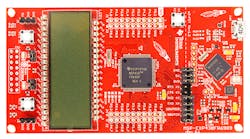This file type includes high resolution graphics and schematics when applicable.
FRAM, a not-so-new non-volatile memory technology, is gaining traction in ultra-low-power microcontrollers due to its advantages over traditional memory technologies. Texas Instruments’ Will Cooper, Product Marketing Engineer for MSP microcontrollers, sheds some light on the technology.
Wong: What is FRAM anyway?
Cooper: FRAM stands for “ferroelectric random access memory.” It is a non-volatile RAM that stores data as a polarization of ferroelectric material (lead-zirconate-titanate). As an electric field is applied, dipoles shift in a crystalline structure to store information.
Wong: How long has FRAM been around and where is it being used?
Cooper: TI has been developing MCUs with embedded FRAM since March 2012. Since then, more than 100 million units have been sold, and FRAM is commercially proven in the semiconductor market. To date, the MSP microcontroller family contains hundreds of options in its FRAM MCU portfolio. We have seen the standalone memory become a very popular choice in high-quality industries such as automotive.
Wong: How reliable is FRAM?
Cooper: FRAM is a very robust and reliable memory technology, even at high temperatures. FRAM retains its data for more than 10 years at 85°C, or 100 years at 25°C. This far exceeds the requirements for most applications and highlights the robust data-retention benefits of FRAM. Standalone FRAM is also used in several automotive applications with qualification to withstand the extremely harsh conditions. From a security standpoint, FRAM is resistant to all forms of electric and magnetic fields, as well as radiation that could cause potential data corruption in other forms of memory.
Wong: Other than low-power consumption, does embedded FRAM into MCUs have a special advantage over other MCUs?
Cooper: Yes. The value of FRAM in a microcontroller is undeniable, especially in applications involving logging of sensor data. It offers the non-volatility you would expect from flash or EEPROM, as well as the ease of use associated with writing to RAM. In addition, it offers write speeds close to that of RAM with up to 1015 (a quadrillion) write-cycle endurance. This means FRAM allows more sensor data points to be stored to help improve decision-making in applications. Additionally, FRAM is unique in its ability to partition code and data to the developer’s specifications, meaning the same microcontroller could be leveraged for multiple projects and that large RAM applications no longer require adding cost to a system.
Wong: What makes FRAM writes so much faster?
Cooper: Unlike typical flash-based microcontrollers, non-volatile FRAM does not require a charge pump, buffering, or pre-erase of data before a write. This essentially gives FRAM the ability to add efficiency to a system requiring data logging. This means FRAM provides on-the-fly writes that can lower power consumption when recording data over a high-speed communication channel. In a practical application, this can even save power when running wireless firmware updates, by reducing the time running the wireless transceiver.
Wong: What kind of memory ranges and features will be available in TI’s FRAM MCU portfolio?
Cooper: Our portfolio offers 4 to 128 kB of non-volatile FRAM. Built on the industry-leading MSP430 MCU core and many of the same peripherals, the ultra-low-power MSP430FRx MCU portfolio offers pin- and software-compatible options ranging from the MSP430FR2x MCUs that start at $0.99 USD to the highly integrated MSP430FR6x MCUs. This latter MCU family includes up to 24-MHz operating frequency, up to 83 GPIO, and 11 packages. Across the family, differentiated features include a 320-segment LCD controller, IR logic, and a dual analog front end (AFE) in the form of our Extended Scan Interface (ESI).
Wong: As a differentiated portfolio of MCUs, what is the cost associated with using one of these devices?
Cooper: Our MSP430FRx microcontrollers start at just $0.99 at 1ku pricing. These MCUs can actually help differentiate consumer products from competition with the advantages of FRAM and the ability to reduce power consumption (under 500-nA RTC standby mode on the MSP430FR5969), yet they are cost-competitive in the industry based on total memory size and feature set.
Wong: Are there any MSP430FRx-based MCUs that are drop-in replacements for flash-based MCUs? What, if anything, needs to change on my code?
Cooper: MSP430FRx microcontrollers are built for, and add value to, a broad set of applications, ranging from home-automation products to smart meters where flash-based MCUs have been prevalent. The ability to write to FRAM, like developers do with RAM, can actually simplify development. Some of the key considerations when starting development on FRAM MCUs include understanding how to partition the memory (i.e., data and application code) and the differences between access and cycle-time requirements compared to other memory technologies. TI has developed some in-depth migration guides to help developers throughout the process. Additional migration guides are also available on our product pages to ease transition between other MSP microcontrollers.
Wong: What’s the easiest way to get started?
Cooper: Once you understand the fundamentals of FRAM technology and key considerations for developing with it, a number of tools are available to accelerate evaluation and design. You can start with a low-cost LaunchPad Development Kit and the Energia development environment for rapid prototyping to quickly evaluate the MCU with a standard connector to attach sensors, or even wireless transceivers into the BoosterPack form factor. We then offer the ability to jump into full-scale development with TI’s Code Composer Studio IDE or IAR’s Embedded Workbench. These development environments even feature libraries that leverage the speed and non-volatility of FRAM to enable context save and restore when power failure occurs. They also include optimization tools such as EnergyTrace technology for power profiling on MSP MCUs.
Wong: How do TI’s FRAM microcontrollers enable the Internet of Things?
Cooper: More data is critical to establishing the Internet of Things (IoT). Getting data from an environment will require more sensor nodes. These sensors can benefit from the speed, power, and endurance of FRAM technology. In addition to the benefits of FRAM, the diverse TI ecosystem of wireless transceivers can be easily leveraged to connect your sensor nodes. Libraries for connecting MSP to modules like the SimpleLink Wi-Fi CC3100 wireless MCU, paired with one of TI’s cloud ecosystem partners such as Exosite, can help enable end-to-end solutions. Additionally, TI has offerings that include Bluetooth Smart, ZigBee, and even sub-1-GHz solutions to help connect sensors in a wide array of IoT applications.
This file type includes high resolution graphics and schematics when applicable.
Reference:
“What is FRAM” (Texas Instruments)



